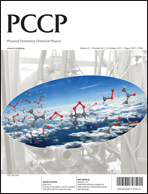Dark state vibronic coupling in the Ã(2Π) ← ![[X with combining tilde]](https://www.rsc.org/images/entities/i_char_0058_0303.gif) (2Σ+) band of ethynyl radical via high resolution infrared absorption spectroscopy
(2Σ+) band of ethynyl radical via high resolution infrared absorption spectroscopy
Abstract
The high resolution ![[X with combining tilde]](https://www.rsc.org/images/entities/i_char_0058_0303.gif) (2Σ+) origin band of jet-cooled ethynyl radical (C2H) in the gas phase is reported, which exhibits a strong, parity-specific local perturbation in the upper 2Π1/2 state. Based on revised parity assignments of the levels, the perturbing state is unambiguously determined to be 2Σ+ symmetry, and thus coupled to the à (2Π) state by ΔK = ±1 Coriolis interactions. By incorporating Σ-Π Coriolis coupling into the unperturbed Hamiltonian (containing only rotational, spin-rotational, spin-orbit, and lambda-doubling contributions), we are now able to fit the observed 2Π-2Σ+ origin band to a sub Doppler experimental uncertainty of 15 MHz (0.0005 cm−1). In addition, the observation of pairs of transitions to mixed states permits determination of the band origin (νpert) and rotational constant (Bpert) for the “dark” 2Σ+ state, which prove to be in remarkably quantitative agreement with full vibronic predictions of Tarroni and Carter as well as UV dispersed fluorescence studies of Hsu et al. This represents an important benchmark in mapping out non-Born–Oppenheimer vibronic interactions and energy level structure in a polyatomic combustion radical system, an understanding of which will be key to modeling chemical reactions in both terrestrial and astronomical environments.
(2Σ+) origin band of jet-cooled ethynyl radical (C2H) in the gas phase is reported, which exhibits a strong, parity-specific local perturbation in the upper 2Π1/2 state. Based on revised parity assignments of the levels, the perturbing state is unambiguously determined to be 2Σ+ symmetry, and thus coupled to the à (2Π) state by ΔK = ±1 Coriolis interactions. By incorporating Σ-Π Coriolis coupling into the unperturbed Hamiltonian (containing only rotational, spin-rotational, spin-orbit, and lambda-doubling contributions), we are now able to fit the observed 2Π-2Σ+ origin band to a sub Doppler experimental uncertainty of 15 MHz (0.0005 cm−1). In addition, the observation of pairs of transitions to mixed states permits determination of the band origin (νpert) and rotational constant (Bpert) for the “dark” 2Σ+ state, which prove to be in remarkably quantitative agreement with full vibronic predictions of Tarroni and Carter as well as UV dispersed fluorescence studies of Hsu et al. This represents an important benchmark in mapping out non-Born–Oppenheimer vibronic interactions and energy level structure in a polyatomic combustion radical system, an understanding of which will be key to modeling chemical reactions in both terrestrial and astronomical environments.
![Graphical abstract: Dark state vibronic coupling in the Ã(2Π) ← [[X with combining tilde]] (2Σ+) band of ethynyl radical via high resolution infrared absorption spectroscopy](/en/Image/Get?imageInfo.ImageType=GA&imageInfo.ImageIdentifier.ManuscriptID=C1CP21523J&imageInfo.ImageIdentifier.Year=2011)

 Please wait while we load your content...
Please wait while we load your content...
![[X with combining tilde]](https://www.rsc.org/images/entities/h2_char_0058_0303.gif) (2Σ+) band of ethynyl radical via high resolution
(2Σ+) band of ethynyl radical via high resolution